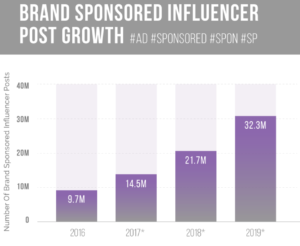Instagram – the (not so) hidden influencer building up the business
When one business model is not enough.
The following paragraphs are a collection of thoughts from all group members, who have covered different perspectives regarding the influence of Instagram on the behavior of its users. We focus primarily on the influence of companies, algorithms, advertising and content creators on users. Enjoy reading it!
Instagram helps nudging users
Can we imagine how much the way of doing business has changed since the advent of social media? How the need to feel connected has changed our habits and perception of reality? We do not always bear in mind that due to this freedom we probably have lost some freedom. Especially in this paragraph, we are going to briefly analyse the behavior economic perspective. So how is nudging, which is a way for influencing people through indirect suggestions, employed by companies, politicians. This does not only mean a mere change in behavior, but goes deeper by touching parts inherent in our character and our way of thinking. We do not realise it, but it happens.
This aspect is very interesting if we consider the way by which companies can influence us. John Davidson in “The Age of Surveillance Capitalism exposes tech giants’ social engineering”, Financial Review (2019), suggests that advertisers would use the behavioural predictions to try to modify user behaviour, getting the users to buy what the advertisers were selling by approaching the users with a proposition that “foresee the future” and is well-timed. Surveillance capitalism practices are spreading a lot in these years, this is also a result of companies entrusting on social media.
Let’s think about how many companies started their Instagram business. Let’s compare with a company that was born 30 years ago. Which is the difference? An important one is that now companies can affect, often indirectly (nudging), not only consumer preferences. They can also influence the opinion of possible investors, the market itself
Let’s think about how many people have been connected to Instagram during the covid period. Not only the business world may have taken benefits from this. In fact, we can think about how many politicians, for example in Italy, Switzerland, Germany, Denmark, have “entered the voters’ houses”. Instagram has become a social space for advocates of women’s rights, for example. A room where the minorities have had their spaces.
Therefore, we realise that everything is interconnected. That there are not necessary boundaries between politics and economics, for example. Data and information that, often involuntarily, we provide partially define who we are. For this reason, they can be used as a very important asset to develop business.
Instagram decides, who deserves your attention
With the increase of Instagram’s user base, there was a need to structure interaction within this platform. Even if we have the freedom to choose our friends on Instagram, it seems that the platform controls our social relations tremendously. Even if Instagram’s algorithm supports us to handle the immense content, which our friends or “followers” are continuously sharing with us, the collected data can be seen as an “behaviour surplus” to modulate with whom we are interacting with. Of course Instagram’s algorithm is kept a secret. However, when we are looking into our account and take a closer look into our social interactions, it seems that people who are similar to us and who share the same interest, follow the same people and interact more often with you are placed more prominently in the feed or in the story and live section, which creates a filter bubble within your social network. It limits you to interact with people you are not often in touch with. These people are easily lost in the immense data set you are faced with everyday. This happens hidden and unconsciously without you noticing it. At this point this may seem very harmless. However, when we start to think about it, we realize that it is an intervention and limitation of the freedom of choice. Even if Instagram’s user-generated data may have positive effects such as service improvement, new functions and increased convenience with an easier interface, the collected data can be used to restrict us and nudge us to the way Instagram expects us to see content and interact.
Not only peer-to-peer communication seems to be affected by the algorithm. The Instagram algorithm controls the attention of the potential consumers for advertisements on the platform as well. Based on the user-generated content, Instagram can enable target marketing, while content is only sent prominently to the right user base. As the attention economy theory claims, user’s or consumer’s attention within the plattfom can be seen as a source of income. It is Instagram, who has the power over which brand is getting this attention from the user base and the resulting income. Consequently, this power of Instagram over attention and control can lead to the power of Instagram over our social and consumption behavior and as well.
Influencers and paid posts
 The more interaction we have with the product, the more familiar and confident we feel purchasing it. This is the reason why influencer marketing entered on Instagram. Influencers are people who have built a large and engaged following on Instagram; their followers trust them and, consequently, their opinions, feeling like they know them personally and considering their recommendations as they were friends. For those reasons, the emergence of Instagram influencers opened up huge opportunities for businesses looking to authentically market their products to their target audience, and thus the “paid post” phenomenon was born. As a matter of fact, in 2019 influencer marketing on Instagram generated over $2.3 billion and 32.3 million brand sponsored influencer posts were registered.
The more interaction we have with the product, the more familiar and confident we feel purchasing it. This is the reason why influencer marketing entered on Instagram. Influencers are people who have built a large and engaged following on Instagram; their followers trust them and, consequently, their opinions, feeling like they know them personally and considering their recommendations as they were friends. For those reasons, the emergence of Instagram influencers opened up huge opportunities for businesses looking to authentically market their products to their target audience, and thus the “paid post” phenomenon was born. As a matter of fact, in 2019 influencer marketing on Instagram generated over $2.3 billion and 32.3 million brand sponsored influencer posts were registered.
Even if it is mandatory to specify that a post is sponsored, making clear to the consumer the commercial intention, sometimes it does not happen; in this sense, people are misled and they even trust more a post because they believe it is not paid. Fortunately, heavy penalties were introduced for these actions. Moreover, nowadays the frequency of advertisements seen in the average stream appeared to dramatically increase; instead of seeing an advertisement two or three times per session, users have started seeing an ad post every five to six photos. In this sense, users are bombarded by endless posts which they don’t require. In fact, influencers’ feed is overwhelmed by ads and their daily life content takes second place. So the question is, how much can an influencer exceed the limits in order to make ads a truly recommended product and not just a profit?
How does Instagram control thoughts and feelings?
 Instagram is a platform, which reflects people’s lives, or at least what they want other people to perceive of their lives. Through the constant comparison with other users and other lives, people are judging and being judged based on the content they see and upload. The frequent and intensive users of the platform are relying on likes and comments to give them an impression of how other people perceive them. This constant need to be seen as being “beautiful”, “cool”, “rich”, “popular”, “interesting”, can very quickly become addictive and put an immense pressure on individuals. This need for other’s approval enhances psychological pressure and can lead to intense depression, anxiety and a decrease in self-esteem.
Instagram is a platform, which reflects people’s lives, or at least what they want other people to perceive of their lives. Through the constant comparison with other users and other lives, people are judging and being judged based on the content they see and upload. The frequent and intensive users of the platform are relying on likes and comments to give them an impression of how other people perceive them. This constant need to be seen as being “beautiful”, “cool”, “rich”, “popular”, “interesting”, can very quickly become addictive and put an immense pressure on individuals. This need for other’s approval enhances psychological pressure and can lead to intense depression, anxiety and a decrease in self-esteem.
Instagram also enhances the obsession of oneself and therefore awakens the narcissist in each of us. Increasing the fixation of our own reflection. In that sense, Instagram is intensifying the need for social answering. Even though the human being wasn’t made to receive social acknowledgement through digital acceptance. Each human being has a need for physical closeness and in-person social answering in order to satisfy their social needs. The social answering users perceive through Instagram comes with an important feeling of void and emptiness, as the social acknowledgement one receives through the digital platform isn’t technically “real”. Thus, distorting the feeling of what is real and what isn’t.
Another aspect of Instagram, is the exclusive reliance on others’ opinions of you. This can be related to Sartre’s famous quote “l’enfer c’est les autres” (Hell is other people), in which people only perceive themselves through the eyes of others. Instagram is only giving you a glance of others perception of you, which can in many situations distort the feeling you have of yourself.
All in all, Instagram has an enormous impact on how people feel and think, especially about themselves.
Liveness as business model
As mentioned, the algorithm always prioritizes content from accounts whose users often interact. That’s why followers and content creators or influencers have to often comment on the posts or react through stories, so the algorithm recognizes that both users are “close” to each other.
From my own experience I can say that I often feel used and reduced to being a consumer only on Instagram. Because in the end most of the posts and accounts are simply “advertising spaces/slots” that want to bind me to their profile and their advertised products through a fake and pretended interest in my person. But isn´t that exactly the twist of Instagram? I am expecting it to be authentic. I am convinced that the other profiles and content creators do have a real interest in my answer on the comment, my feelings and that they do care about me and my stories. But most of them just want to sell stuff and make money with users.
While watching stories and reading posts we tend to forget that Instagram is a business. In recent years, the original business model of the photo and video sharing platform has changed to that of an online marketing and advertising business model. The simplicity, a strong visual component and a high usage rate make Instagram the advertising platform of today. Furthermore, the business model of instagram has been and is based on a number of tools and features it offers, such as filters, stories, IGTV and live sessions. The live sessions can therefore be seen as another link and a push for the interaction and belief of the users in the authenticity of the creator. They thus serve as an opportunity to bind users even more to the platform.
Aurora De Martin, Emaele de Quatrebarbes, Lara Schulte, Marco Ubalducci & Selma Vuckic